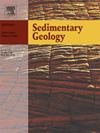穆拉-盖巴斯盆地中新世沉积盖层:西班牙南部贝提克山脉内外带边界
IF 2.9
2区 地球科学
Q1 GEOLOGY
引用次数: 0
摘要
西班牙东南部的Sierra Espuña和Mula-Gebas山内盆地代表了北部山东部的内外带边界(IEZB)。该盆地中新世的充填物封闭了IEZB,主要来自内部带。该沉积与晚中新世火山作用同时期。因此,这些沉积物的研究对西环地中海链山内盆地发育过程中源区物源、分选与再循环、古气候、风化、拆顶和构造过程具有重要意义。砂岩碎屑模式和泥岩的矿物学和化学组成被安排在两个沉积旋回中:(1)布尔底加里世中期—朗吉安期早期,(2)托尔顿世中期—墨西尼亚期早期。石英岩-长石质岩屑岩反映了从岩屑-过渡-石英-再循环造山带到过渡-再循环造山带的侵蚀作用,因为存在中低变质岩屑和与安山岩、安山岩-英安岩和流纹岩-流纹岩来源的罕见同世火山。泥岩为长英质(花岗片麻岩)烃源岩,上中新世有少量镁铁质输入。也证实了浅埋历史和低热条件(< ~ 50°C)。此外,古气候由中中新世的暖湿气候向晚中新世的寒冷干旱气候转变。本文章由计算机程序翻译,如有差异,请以英文原文为准。
The Miocene sedimentary cover of the Mula-Gebas Basin: Internal-External Zone Boundary of the Betic Cordillera, South Spain
The Sierra Espuña and the Mula-Gebas intramontane basin, SE Spain, represent the Internal-External Zone Boundary (IEZB) of the eastern Betic Cordillera. The Miocene infill of this basin seals the IEZB and is mainly derived from the Internal Zone. This deposition is coeval with a Late Miocene volcanism. Therefore, the study of these sediments is crucial for the source-area provenance, sorting and recycling, paleoclimate, weathering, unroofing and tectonic processes, during the intramontane basins developing of the western peri-Mediterranean Chains. Sandstone detrital modes, and mineralogical and chemical compositions of mudrocks were arranged in two sedimentary cycles: (1) the middle Burdigalian-early Langhian, and (2) the middle Tortonian-early Messinian. The quartzolithic to feldspathic lithoarenites infer the erosion from a lithic-transitional recycled to transitional-quartzose recycled orogen, since low-medium grade metamorphic lithics and rare coeval volcanics with andesitic, andesitic-dacitic and rhyodacitic-rhyolitic sources are present. The mudrocks reveal a felsic (granitic-gneiss) source with a minor mafic input in the Upper Miocene. A shallow burial history and low thermal conditions (<∼50 °C) has been also evidenced. Moreover, the paleoclimate changed from warm and/or wet during the Middle Miocene to cold/arid in the Late Miocene.
求助全文
通过发布文献求助,成功后即可免费获取论文全文。
去求助
来源期刊

Sedimentary Geology
地学-地质学
CiteScore
5.10
自引率
7.10%
发文量
133
审稿时长
32 days
期刊介绍:
Sedimentary Geology is a journal that rapidly publishes high quality, original research and review papers that cover all aspects of sediments and sedimentary rocks at all spatial and temporal scales. Submitted papers must make a significant contribution to the field of study and must place the research in a broad context, so that it is of interest to the diverse, international readership of the journal. Papers that are largely descriptive in nature, of limited scope or local geographical significance, or based on limited data will not be considered for publication.
 求助内容:
求助内容: 应助结果提醒方式:
应助结果提醒方式:


